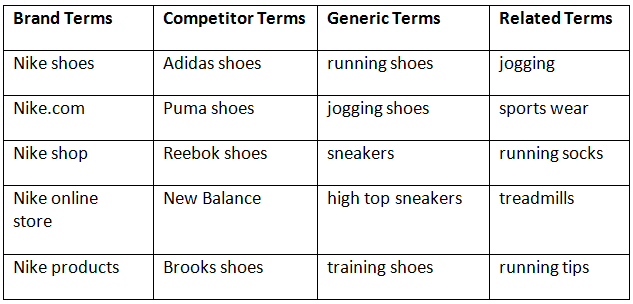For a successful PPC campaign, best keywords research is most important. You have to select a bunch of keywords which are most likely to convert. Consider keywords research mix of science and art.
Before doing keywords research you have to understand your customer or users and find out which search terms they will use to search your product and service. By doing so, you can assure yourself that your ads will appear at the right time and in the right place.
From our PCC keywords research Guide, you’ll learn how to acquire, refine, and group your PPC keywords, so that you will get more targeted and more effective pay-per-click campaigns.
Get ready for some brainstorming around keywords and its types:
Before starting the keywords research you should scan through all your website landing pages to which you wanted to send traffic. You should take out all your relevant keywords from these landing pages. It will help you to take out a handful of relevant keywords that will be directly related to your product and service.
Now you can organized your keywords in the following types:
- Brand Search terms – any search terms will contain your brand name and trademarked.
- Generic Search terms – any search terms related to products or services offered.
- Related Search terms – this search term is not directly related to your product and service, but the user might be searching for your product.
- Competitor Search terms – search terms contain brand names of competitors who are offering similar products and services to yours.
Let’s have some examples for the above mentioned types. For instance, I wanted to set up the campaign to advertise Nike running shoes, then my list of keywords looks like this:

Here is a Note:
Before Bidding on a competitor’s brand search terms you should know that it will usually be expensive and will consume most of your budget. So before targeting the competitor search you should have a comfortable cushion of budget to play around the competitor. Therefore, think carefully on ROI whether it’s worth it or not.
More Tips Around Keyword Brainstorming:
Think about User Behaviour: You should have to brainstorm around what queries and words they will use in search to bring them your website?
Start with a broader keyword, and move to more specific keywords. For example:
Shoes -> Women’s Shoes -> Women’s Running Shoes -> Women’s Pink Running Shoes
You should include keywords with product variations and synonyms in your list.
Search engines are smarter, they can automatically make connections between related search terms like between “sneakers” and “running shoes”, but it doesn’t happen always, so it’s best to include them in your keyword list, especially when you’re planning to add your keywords as an exact match type. Same do this for plurals keywords, abbreviations and short forms of keywords.
Taking the keyword “women’s pink running shoes” from above, I would probably jot down variations like:
- Women’s pink running shoes
- Women’s pink running shoe
- Women’s pink running boot
- Women pink running shoes
- Women pink running shoe
- Women pink light shoe
- Women running shoe
While selecting keywords consider specificity:
For some of us, it can be effective to include “head” terms or broad terms like single words because they have higher search volume – but Head term like “shoes” could be used by people searching for women’s shoes, kid’s shoes, men’s shoes, and so on, so your product might be not relevant to them.
On the other side, using long-tail keyword phrases like “men’s black running shoes” might only get a few searches per month, but users are more likely or prefer to click your ad and proceed toward purchase because your product is exactly what the user is searching for.
There is an additional bonus of using long-tail keywords is that they are less competitive and therefore they are less costly.
Add keywords related to product or service:
By adding related keywords, it will help you to attract the buyer who will be more likely to be interested in your product and service which you are selling.
Let’s take an example if you are selling cat food you could include keywords that cat owners would search for, such as cat grooming, cat breeds, cat health issues, cat sitters, cat accessories, and so on.
Use a method called “concatenation”
Here is the one more tip to quickly expand keyword lists by merging columns of words together using online tools like merge words.
Like in the example below we have put the product keyword in the third column, and in the first column we add product type and a second column we add product colour, and then the tool will generate a list of all possible permutations of those nine terms.
Search engines are smarter they understand longer search strings:
Now searches over voice are growing. People prefer Voice led queries by speaking questions into their mobile phones to search for things on the go. So we also have to add these search terms into your list of keywords.
These search terms are like traditional keyword search query might be “Chinese eatery Delhi” but someone searching on a phone might say “what’s the best Chinese eatery in Delhi?” or “where can I get Chinese food in Delhi?”
Expand and Refine Your Keyword by using Tools
After making your list of seed keywords, your next step is to utilise the keyword research tools to determine which keywords to keep and to drop.
With your seed keywords list you cannot go with your guts – keyword tools will help you to get the terms that people are actually searching on search engines.
There are many tools available that will give you insights into how popular certain keywords are, from Google’s Keyword Planner to other free Keyword Suggestion Tools.
Each keyword research tool is a little different, but the main thing that you have to look for is keyword search volume. You can see higher the keyword search volume, the more people are searching for that given keywords per month.
In Google Ads Keyword Planner you can also check the “Competition” column with Competition ranking in terms of high, medium, or low. The higher the competition means more advertisers are bidding on these keywords and you have to pay more to compete for top positions.
Keywords with high Search volume and low-competition are the sweet spot:
You should look for the keywords which are higher search volume but low competition. It will give you substantial traffic without costing you high.
Keyword tools like Google Keyword Planner suggest additional keyword ideas that you missed in your initial stage. There are some other free keywords research tools also available like Ubersuggest and Soovle can also help with this as well.
Keywords which have low search volume, with high competition, will drain your budget so quickly, so drop them from your list.
Selecting and Grouping Your PPC Keywords
Now you have selected some impressive keyword lists. Now you have to sort your keywords into targeted groups that are closely related to each other. These keyword groupings correspond to your ad groups in Google Ads (or Bing Ads, etc.).
Here the keyword grouping tip is to group the keywords as per the structure of your website. For example, if you’re selling cat food, your campaign might look something like this:
Brand – Purina Cat Food
Brand – IAMS Cat Food
Brand – Royal Cat Food
Generic – Cat Food
Generic – Cat Food – Chicken
Generic – Cat Food – Beef
Generic – Cat Food – Kibble
Generic – Kitten Food
If your ad groups are more focused then it will be easier to:
- Measure the performance of each keyword
- Prune or expand your keywords lists if necessary
- Create highly relevant and keywords specific ads
Well-organized ad groups and campaigns will have more relevance, and higher relevance keywords will have higher quality scores, it will increase your ad rankings and reduce what you pay for each click and each conversion. Healthy PPC accounts will always have healthy quality scores, and strong keyword organization will improve your overall scores.
Also Search for Negative Keywords
After creating your keyword list, now you also have to add negative keywords. These are the terms for which you don’t want your ads to show up for. Adding negative is an important part of a successful campaign. It will help you to control your costs and keep your ad targeting as relevant as possible.
The main purpose of adding a negative keyword is that it will prevent your ads from triggering for some irrelevant terms that are not related to your business.
Let’s take an example: a seller of high-end appliances or decor would want to target affluent customers so they will add terms like “cheap” and “free” to their negative keyword list to prevent their ads from appearing for those search terms.
One more reason for adding the negative is that you have to rule out impressions on terms that are not related to your business – like “hair dryer” is your negative term when you are selling home appliances including washers and dryers.
Some tips to finding out negative keywords for your campaigns:
- Always go through your search query reports: You have to go through words in your search query report and find out some of the words which might not be a good fit for your account, add them as negatives so that you save yourself from extra spend.
- Which Match types for Negative: If you assign the wrong match type to your negative keywords then it might also block your potential traffic. So first thing to do is that you should add a negative with a broad match to disqualify any query that contains your negative term, such as “free.” Use phrase match and exact match negatives to disqualify more specific search terms.
- Add a Negative Keyword before the campaign launch. The more negatives you set before a campaign launch, it will help you to save the more budget beforehand. You can add negative while researching for your keywords from the keyword suggestion from tools.
- Add Multi-Level Negatives: There are some negatives that are good fits across multiple ad groups or campaigns you can add it to all.
- Don’t Overload the Campaign with Negatives! Now you know that negatives are an important aspect of a successful PPC campaign, it will help you to save your budget. But if you excessively added the negative in your campaign then it will hurt your account performance by killing your impression and clicks. While adding the negative you should assure yourself that these searchers are highly unlikely to convert.
Last thing is that you should keep going with your keywords research! Because You’re not going to discover every keyword in PPC in the first go. Therefore you should give 15% of your PPC management time to PPC keyword research.
It is ideal if you are doing keyword research every week like adding new keywords and testing new match types and adding new negatives. Over a period of time, your account will become stronger and more relevant by practicing the same.





